Arc Studio Screenwriting Application Review

Buy Arc Studio now:
Arc Studio Review
The folks from Arc Studio reached out to me and asked me if I wanted to give their screenwriting software a spin, and I said “yes”.
And just so you know, this is not a sponsored video, I’m using the free trial for this review. I don’t get anything out of it, neither do they, so, I just want to show you around a little so you get an overview of what Arc Studio can do for screenwriters.
I will check the software for the following things:
- Does it have the necessary functionality for screenwriters?
- How is the writing experience?
- How can you get your stuff in and out?
- Does it have anything special that other writing applications don’t have?
- What does it cost?
And then, at the end, of course, you’ll get my conclusion.
Before we go into it, let’s talk about some general things about Arc Studio.
If you want to try or buy it, go to https://arcstudio.com.
It’s a browser-based application, or web-app if you will. That means you can write directly in your browser, and your scripts are stored in the cloud. You can also download an offline application for writing on your desktop, even without internet connection, and then when you log back on, the changes will be synced to your projects.
So, comparable to that are applications like WriterDuet for example, or celtx. They also use the cloud-based system, as opposed to cloud-less applications that store the documents that you produce basically wherever you save them.
The advantage of cloud-based writing applications is that everything is stored and backed up on the servers, in this case the Arc Studio servers, or on the cloud system that they might be using.
If you want to give Arc Studio a try, there is a free 7-day trial, in fact, I’m using this exact 7-day trial to show you this.
One more thing before we start, if you want to compare different writing applications in detail to one another, or if you want to really deep-dive into the one you are using, you might want to check out my Writer’s Territory Course platform. There you get professional writing applications courses for industry standard software for a low, monthly fee, and that also has a 7-day trial so you can see if that is something for you. Be sure to come back and check every now and then, because I’ll constantly be adding new tutorials.
Does it have the necessary functionality for screenwriters?
OK, the first thing I want to see about Arc Studio is if it has the necessary functionality for screenwriters. The question is, what is the necessary functionality? In this case I mean, I just want to see if what Arc Studio offers with this current release makes sense in terms of, do you have everything that you need to handle the whole writing workflow, or is something missing.
So, let’s have a look.
And right off the bat, for now, that answer has to be “yes” and “no”. I would’ve said “yes”, and we’ll go through some of the functions that it offers in just a second, but on their website they say it can do everything that Final Draft can do and more. And right now, I don’t see that. Because there is one big area missing that Final Draft has been offering for many years, if not since the beginning, and that is production features for the whole revision process.
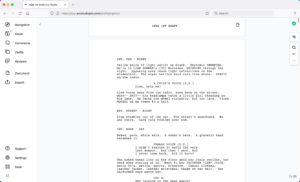 But it doesn’t matter. I don’t see that as a problem for now, and if you go to the “Production” menu, there is says, “Beta”, so, obviously they’re working on it, but it’s not ready yet.
But it doesn’t matter. I don’t see that as a problem for now, and if you go to the “Production” menu, there is says, “Beta”, so, obviously they’re working on it, but it’s not ready yet.
So, the claim is a bit bold, but if you don’t need production features right now, it doesn’t really make a difference.
Because apart from that, Arc Studio really offers you all the features that you might be used from other screenwriting applications as well.
And a little bit more, even, depending on which you compare it to.
You have a nice navigation bar where you see a preview of your scene heading and a little bit of the scene content, …
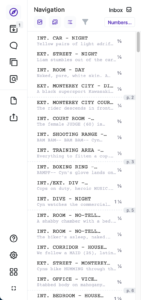 … you have a commenting function that includes tagging, so you can sort your comments in different categories.
… you have a commenting function that includes tagging, so you can sort your comments in different categories.
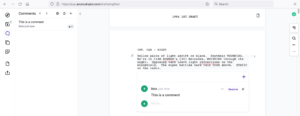 You have collaboration, you can share your script with others, and then you can work with them in real time.
You have collaboration, you can share your script with others, and then you can work with them in real time.
You have outlining features, which are actually more advanced than in many other writing applications. It’s not just index cards, but you get a board, on which you have sections, like for example one section for each act, and then you can place your beats there, you can connect them so scenes if you want, but you don’t have to, which is nice.
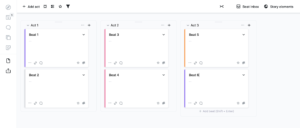 And, you also get, which I think is very handy, so-called “Storylines”. These are through-lines in your story that you want to track, and that you can connect your beats to.
And, you also get, which I think is very handy, so-called “Storylines”. These are through-lines in your story that you want to track, and that you can connect your beats to.
And then what you get is this timeline view where you can define what they call “story values” at the points of the beats that these storylines are attached to. This should give you a visual representation of certain developments through your story.
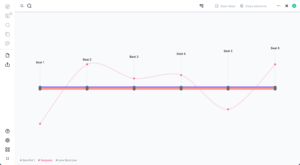 And although there are things I dislike about the way the outlining functions work here, which I will come back to later, I think this storyline feature is a really nice addition and might actually be of great help when you’re developing a story.
And although there are things I dislike about the way the outlining functions work here, which I will come back to later, I think this storyline feature is a really nice addition and might actually be of great help when you’re developing a story.
Alright now, all in all you see, all the stuff that you need is there, so I’d say in terms of functionality, Arc Studio checks, well, not all the boxes they say they check, but everything that I would like to see in a screenwriting application is there.
Writing Experience
So, next, let’s see what the writing experience is like.
There is one thing that for me is the worst when it comes to writing applications, and that is when they have a lag when you’re writing. And interestingly enough, I’ve seen it on browser-based AND “offline” programs, although in recent years, it hasn’t been that much of a problem anymore.
Adobe Story comes to mind, that was the worst of all in this regard. But that’s discontinued anyway, so… back to Arc Studio.
Arc Studio works in the usual TAB and ENTER key fashion. You jump between the different screenwriting elements, like scene heading, action line, dialogue, and so on, with these two keys.
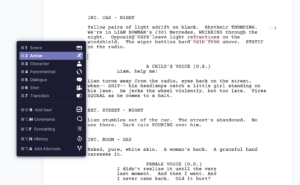 Arc Studio also shows you a little icon at the side, which is handy, so you always know in which element you are.
Arc Studio also shows you a little icon at the side, which is handy, so you always know in which element you are.
And the writing itself works really well. There is absolutely no lag, you can just write away happily, all good.
You also get a distraction-free full screen mode, which is nice. I like to use these.
And also, when you copy and paste large chunks of text, it handles that very well. I’ve seen other browser-based applications almost kill themselves when you start copying and pasting a whole script in there, but with Arc Studio I didn’t have that problem.
So, all good on the writing front, or, in other words, during the short trial testing that I did for this video, I didn’t find anything that I really dislike. I mean yes, every now and then you find a little bug, or something that is not implemented perfectly in this release, but, you know, software development is never finished, there’s always something to smooth out, so, if it’s only really little things, I don’t care.
So, all good on the writing front.
Getting Stuff in and out
Next, let’s look at importing and exporting.
Let’s do importing first.
If you go to the “Import” dialog, they say they import Final Draft fdx, fountain, pdf, and Word.
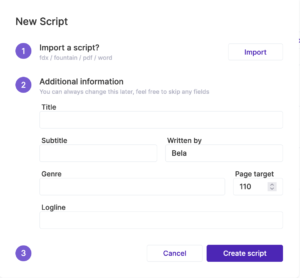 Bold choice to include Word, because the formatting might be all over the place, but anyway. They seem to care about the most used formats, and it is nice to see that they include fountain and pdf.
Bold choice to include Word, because the formatting might be all over the place, but anyway. They seem to care about the most used formats, and it is nice to see that they include fountain and pdf.
Although if you do import a pdf they tell you that the formatting can be off because it depends on how the pdf was created, but when I tested it, it worked well.
And the fountain format makes it very compatible with other writing applications, so if you just want to import some notes for example, you don’t necessarily have to do it via the fdx format.
In terms of exporting, almost the same. You get pdf, fountain, and Final Draft fdx. They say they will support more formats in the future, but with these three, you’ll cover probably 99% of the situations.
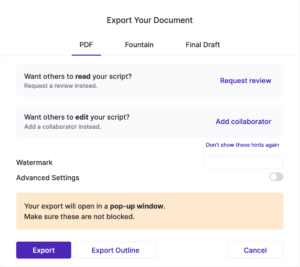 So, all good on the importing and exporting front as well.
So, all good on the importing and exporting front as well.
Does it have anything special?
Next, does it have anything special?
Yes, it does, and we already talked about it. The storyline/timeline feature, however you want to call it. I like that they included it.
However, and I will talk about this a little bit more later on when we talk about the things I don’t like so much.
The storyline feature is great, and it’s kind of similar to timelining tools that I’ve been missing from writing applications for a long time.
The only thing that I’m not so sure of is if you use a lot of these storylines, which I would definitely do if I were to use the software regularly, if you can really have a good overview of all of them, or, in other words, if the storyline view has enough tools to really make good use of this feature. Because you see all your beats on one straight line, there doesn’t seem to be a way to put them on different layers, so my guess is it might get quite confusing when you have a lot of beats and a lot of these storylines in parallel.
But anyway, maybe future updates will take care of this, we’ll see.
Which takes me to …
What does it cost?
… The price.
Let’s compare the price to similar writing applications.
At the time of this recording you have three pricing models. Although, it’s really just two because one is the free plan with limited functionality.
If you pay, you have two options, the “Essentials” plan and the “Pro” plan.
You see a detailed comparison on their website, but the difference between the Free and the Essential is mainly unlimited scripts, and exporting pdf’s without watermark.
And the difference between the Essential and the Pro plan is mainly you get the offline apps – there is an app for iOS by the way, but not for Android – and yes, before you ask, there is a Windows version. And you get outlining tools and collaboration on the Pro plan.
So, the Pro plan is $99 per year.
If you compare that to other screenwriting apps, that’s about what a Final Draft update costs. Final Draft updates are usually between $80 and $100, somewhere in there, and they also come out about every year I think.
The difference is, you don’t need to buy the Final Draft update if you don’t want to. You just keep writing with the version you have.
With Arc Studio, that’s a subscription plan, so you’ll get charged every year if you continue using it.
If you compare Arc Studio to other subscription-based models, it depends a bit on which one, but they all tend to be in the range between let’s say $8 and $12 per months, so it’s roughly about the same price range like for example a WriterDuet subscription, or celtx, depending on the features and your payment plan. If you pay yearly they tend to be a bit cheaper.
Who is is for?
So, who is Arc Studio for?
Because if you take a look at other writing applications, most of them have a strong suit. WriterDuet has been built especially with collaboration in mind. Celtx has a whole film production studio suite connected.
So, who is Arc Studio for?
And this is just my interpretation of course, but it seems to me that what they’re trying to offer is a real alternative to all the other existing screenwriting applications out there, if you’re just interesting in the writing part that is, but with a strong focus on development tools.
The way they approach the whole beat board and storyline topic, and how they integrate with the script, it seems to me that this is one of their main selling points that they want to focus on more in the future.
But we will see. You’ll get my conclusion in a second anyway, so I’ll get back to if I think it’s worth the price or not.
Conclusion
Which brings me to the conclusion.
I already told you there’s something I don’t like about the beat board. Let me start with that, so we have it out of the way.
Let me say what I like about the beat board first, in order to put my opinion into context.
In general, I like the way they approach the whole beat board/outlining thing.
And here’s why: From what I see they try to be as little restrictive as possible with how you use the beats.
You can put them into structure sections, but you don’t have to. You can connect them directly to scenes, but you don’t have to.
And that tells me that they really think about how a writer would use these and what their needs are.
By the way, they also give you ready-made structure templates like 3-act, Syd Field, Save the Cat!, and John Truby, which is really nice. Gives you a good starting point.
So, back to my feedback.
My problem with the beat board is this. The way it is done now, it looks great, it’s usable, it’s easy to make nice videos about it with many colors that makes it all look great.
And that’s good. Nothing bad about that.
But, now, imagine that you are really working with that a lot. And I don’t know about you, but I tend to use a lot of different beats for many elements in the scenes, so when I outline, let’s say, a feature, with this, I know I will end up with hundreds of beats.
Because you can divide a feature in roughly 40–50 scenes, let’s say, and when each scene has at least a couple of beats, you easily end up with 200 beats or more.
Now, let’s take a look at the Beat Inbox. The beat inbox is a place where you can hold just beat without putting them into some kind of structure. You just throw them in there when you don’t really know yet where to put them.
Which is great. That’s how I like to work. I just create beats and beats and beats, and then the sorting and structuring of these beats is an entirely different process.
But the beat inbox is just this little pop-up pane at the side of the screen. Imagine having 200 beats in there. I always have to look to the right. I’ll be using that beat box for a long time. I feel my neck getting stiff already. I would want the beat inbox to be full screen. And then, when I change to the sorting and structuring process, it can be a bit smaller, no problem. Although, not as small as it is right now, because I’d just be scrolling all day looking for my beats.
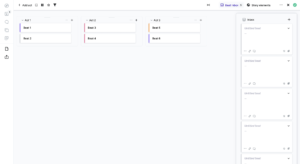 So, the beat inbox is way too small I think.
So, the beat inbox is way too small I think.
Then, the board.
Let’s imagine I sorted all my 200 beats into some kind of structure, but I want to play with different possibilities and variations to see how they play out.
That’s what outlining is, you’re sitting there, for hours, trying different ways of telling the story.
So, imagine now that you have to move many of these beats to and from different structure sections.
And I’m not talking about two or three, I’m talking about large chunks. I might want to move 20 beats here, and 15 beats there, and so on.
But I can’t move more than one beat at a time. There is no way, or at least no way that I’ve found to select several beats at once. I would have to move them over one after the other.
Just imagine moving 20 beats over one after the other manually. And the moving usually works well, but if you’re doing it quickly, sometimes you grab it a little bit in the wrong place, and then all of a sudden by accident you clicked into the name or description field because the program thinks you want to change the name.
No, I just want to move everything over as quickly as possible.
And it’s these supposedly little things that I know would get me personally very distracted from the developing process. I want to think about my story. I don’t want to think about that I have to grab that card in exactly the right spot so that I can move it, instead of edit it. And then repeat that process 20 times.
So, as you can see this is a big issue for me. But it might not be a big issue for you. Everybody works differently.
Apart from that, now let’s get to the positive things.
I have to say, in general, and I’m not the biggest fan of browser-based apps for screenwriting, but having said that, I think Arc Studio has a very nice and sympathetic feel to it, if you can put it that way.
I like the design, it’s very reduced, and helpful, it’s cute, but not distracting.
The writing experience is very good, as it should be, absolutely no complaints there, you have all the functions that you need, and it’s obvious that they are still working on some things in the background, which is fine. You can’t finish everything at once, that’s normal.
They way they designed the functionality tells me they take writers seriously, they totally respect the industry standard, but also are open to new, modern approaches (speaking of the fountain format for example)…
I like it. I really do.
So, if you are looking for a feature-rich writing application and you can spend up to $99 USD a year, you really get something that you can produce professional scripts with. No problem.
If you like to work in browser-based apps, which absolutely has its advantages, above all in terms of having your work backed up all the time, and if the outlining functions work for you, this could be a good application for you to try.
I personally, at this point, I can’t say whether I will use it on an ongoing basis, we’ll have to see how the outlining features develop in the future. I’m not saying I won’t use it, it’s just that, as you can imagine, I have so many to choose from, so, … we’ll see.
But I’ll definitely consider making a deep dive into it, checking all its bells and whistles in detail under the hood and adding as a course to my Writer’s Territory course platform.
Alright, that’s it, I hope your time watching this was well spent, and you could get out of watching this what you were hoping for.
Bye-bye everybody, and may all of you write something amazing!

Buy Arc Studio now: